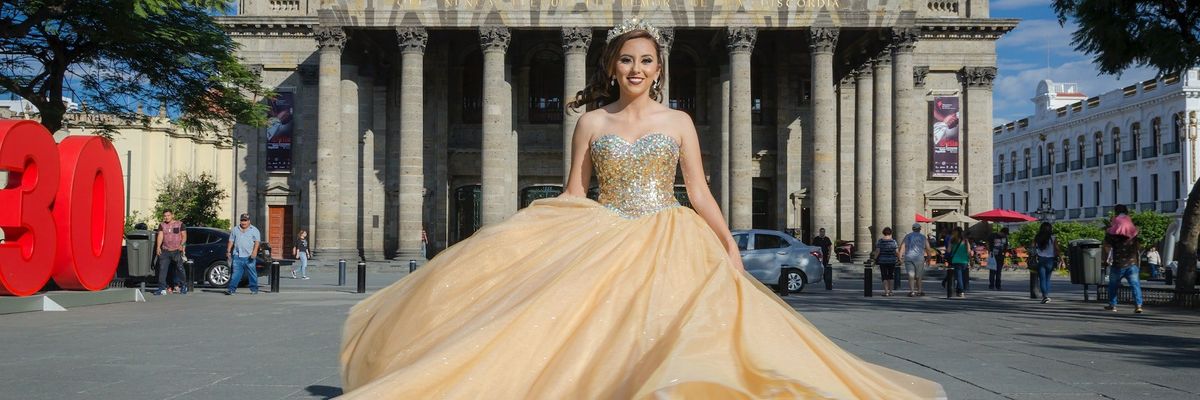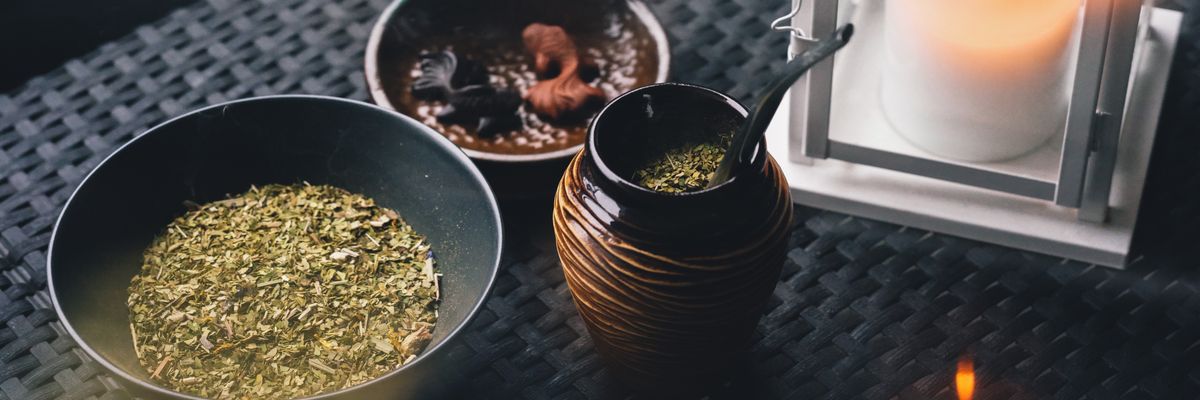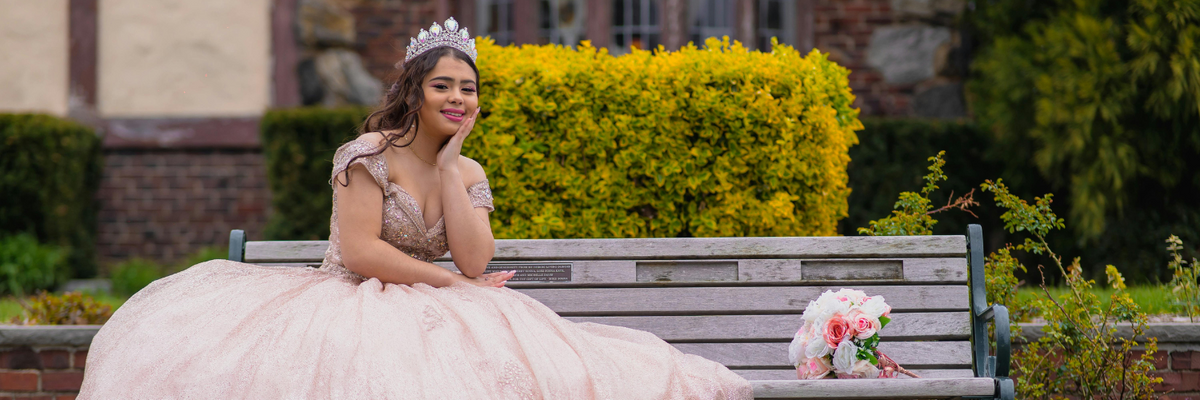Luz Staff
Luz creates compelling, culturally accurate and authentic stories that illuminate the breadth and the depth of the U.S.-based Latina experience. Dismantling stereotypes and destructing harmful narratives are the storytelling goals for every story told.
In The Community
It's more than just an epic birthday bash; it's a meaningful coming-of-age celebration that marks a Latina girl's “journey into womanhood.” Rooted in deep history and brimming with customs, many that have withstood the test of time, Quinceañeras are a testament to the richness and enduring beauty of the evolution of Latino culture.
(who hasn't been caught up in chambelan or madrina drama) and as rich as abuela's homemade mole (those father-daughter dances get you every time).
We dive into where they came from, and where they're going.
Where did the Quinceañera come from?

Photo by Davis Vidal: https://www.pexels.com/photo/woman-in-red-ball-gown-8466251/
Quinceañeras are said to trace their roots back to the indigenous cultures of Mesoamerica, such as the Mayans and Aztecs. Young women were prepared for their future roles as wives and mothers, acknowledged by a coming-of-age ceremony. With the arrival of Spanish colonists, indigenous rites fused with Christian customs, leading to what we recognize today as the quinceañera.
In the past, the quinceañera signified a fifteen-year-old girl's readiness for marriage and motherhood. However, as societies evolved, the celebration began to symbolize the girl's transition into womanhood, emphasizing personal growth and responsibility.
Timeless Quinceañera Traditions

Photo by Christina Langford-Miller on Unsplash
Quinceañeras are a blend of spiritual, familial, and cultural elements that differ from region to region. However, some common traditions often observed include:
- Mass or Blessing: A quinceañera typically begins with a religious ceremony, where the quinceañera gives thanks and seeks blessings for her future.
- The Last Doll: Symbolizing the end of childhood, the quinceañera may receive a doll, often resembling the quinceañera herself. After the ceremony, this is usually given away to a younger sibling or cousin, signifying the quinceañera's transition to adulthood.
- Changing of Shoes: The girl's father or another significant male figure usually replaces her flat shoes with high heels. This act is a touching symbolic gesture, marking her stepping into womanhood.
- Court of Honor: The quinceañera is usually accompanied by a group of young men and women, often consisting of family and friends. They perform choreographed dances, offering a spectacle for the celebration attendees.
- First Dance: The quinceañera shares her first dance traditionally with her father or a father figure. The dance is said to signify her entry into society as a young woman.
- The Reception: This is the grand celebration, complete with music, food, and dancing. It's a chance for everyone to enjoy and partake in the quinceañera's special day.
Quinceañeras Today

Photo by Becerra Govea Photo: https://www.pexels.com/photo/woman-in-yellow-tube-dress-standing-on-gray-concrete-floor-5824360/
While quinceañeras are steeped in tradition, they have also adapted to the times. Today's quinceañeras may incorporate elements that reflect the unique interests and identities of the celebrants. It could range from themed decorations to choreographed dance routines to the girl's favorite tunes. In the U.S., a quinceañera might also integrate 'Sweet Sixteen' elements, making the event a hybrid of cultures.
While modern touches make each quinceañera unique, the core values of family, faith, and community remain central to these celebrations.
Quinceañeras are more than extravagant parties. They are an essential part of the Latino cultural tapestry, intertwining the threads of history, tradition, faith, and community. For young Latinas in the U.S., these celebrations are a rite of passage, affirming their identities and roots while embracing their futures.
Whether a quinceañera leans more traditional or embraces modern trends, the essence remains the same: it is a declaration of growth, strength, and the continuous journey of self-discovery.
- Mixing it Up: 5 Must-Try Latino Cocktails ›
- Remember When? 20 Oh-So-Relatable Experiences If You Grew Up Latino ›
- More Than Just Dolls: Latina Representation in Toys - Luz Media ›
- 20 Latino Experiences We All Know Too Well ›
- Afro-Latinas Are Breaking Quinceañera Stereotypes - Luz Media ›
Coffee might be the go-to pick-me-up for most people, but let's face it, sometimes you just need to spice things up a bit. These drinks have been around for centuries and have become a cornerstone of Latin American culture. So, if you're tired of the same old cup of joe and want to broaden your horizons, these alternatives are definitely worth a shot. Plus, they're all-natural energy boosters that come packed with a slew of vitamins, minerals, and antioxidants.
So, why settle for just a caffeine buzz when you can have a flavor explosion and a healthy boost all in one? Whether you need a pick-me-up to start your day, a refreshing thirst quencher for a sunny afternoon, or a cozy drink to warm you up on a chilly night, these authentic Latin American beverages are sure to become your new favorites.
Yerba Mate

Photo by Komarov Egor 🇺🇦 via Unsplash
This beloved beverage is made by steeping dried leaves from the yerba mate plant in hot water and is enjoyed across Argentina, Uruguay, Paraguay, and Brazil for its delicious taste and energy-boosting properties. It's packed with caffeine, antioxidants, and a heap of other vitamins and minerals, making it the ultimate wellness potion.
To prepare yerba mate, fill a hollowed-out gourd (called a mate) two-thirds full with the leaves, then moisten them with cool water and let them absorb it. Add hot water and steep for a few minutes before sipping on this magical brew. Sweeten with honey or sugar if you like, or add a splash of citrus for some extra zing. And if you're feeling fancy, you can brew it using a French press or tea infuser.
Té de Guayusa

Takiwasi, CC BY-SA 4.0 <https://creativecommons.org/licenses/by-sa/4.0>, via Wikimedia Commons
This tea is a traditional Amazonian drink consumed by indigenous communities in Ecuador, Colombia, and Peru. Made from the leaves of the guayusa tree, it's packed with natural caffeine and other stimulating compounds that'll have you buzzing with energy.
To brew, simply boil 4 cups of water, add 4-5 guayusa leaves, and let steep for 5-7 minutes. Strain, serve hot, and add some sweetness if you have a sweet tooth. Want to take it up a notch? Add some cinnamon or mint for an extra kick.
Pinolillo

GrammarFascist, CC BY-SA 4.0 <https://creativecommons.org/licenses/by-sa/4.0>, via Wikimedia Commons
This Central American drink is the ultimate comfort food in a cup. Made from toasted corn flour, cocoa, and cinnamon, with hints of vanilla and sugar, Pinolillo is a rich, chocolatey beverage that'll warm you up on a cold day and cool you down on a hot one. It's a cultural icon in Nicaragua, Honduras, and El Salvador, where it's sipped on and celebrated by young and old alike.
The best part? The cocoa and cinnamon in Pinolillo contain just enough caffeine to give you a little energy boost without the jitters. To make this tasty drink, simply roast some cornmeal, blend it with cocoa, cinnamon, and sugar, and add hot water or milk to taste. It's that easy!
Guaraná

Bernard DUPONT from FRANCE, CC BY-SA 2.0 <https://creativecommons.org/licenses/by-sa/2.0>, via Wikimedia Commons
Native to Brazil, guaraná has been used for centuries by indigenous communities for its natural caffeine, theobromine, and other energizing compounds. Nowadays, it's a popular ingredient in energy drinks, supplements, and other products. But why settle for pre-made when you can make your own delicious guaraná drink at home?
Mix 2 tablespoons of guaraná powder, 1 tablespoon of sugar, and 1 cup of water in a blender until smooth. Pour it over ice, top it off with soda water, and add a slice of lime. Ah, refreshing and energizing.
Tereré

TitiNicola, CC BY-SA 4.0 <https://creativecommons.org/licenses/by-sa/4.0>, via Wikimedia Commons
Hailing from Paraguay, this refreshing drink is made by steeping yerba mate leaves in cold water, then jazzing it up with ice, herbs, fruits, and sweeteners for a little extra pizzazz. It's typically enjoyed with friends and family, who pass around a shared cup and sip through a metal or bamboo straw called a bombilla. With its many health benefits, including aiding digestion and improving mental clarity, tereré is the perfect drink to sip on a hot summer day.
To make your own, grab a guampa (a traditional drinking cup made from a hollowed-out gourd) and fill it halfway with yerba mate leaves. Add some fresh mint, a squeeze of lemon or lime juice, and a dash of honey or sugar. Then, fill the guampa to the top with ice-cold water or juice and sip away with a bombilla. Salud!
- 5 Tasty and Fresh Latino Springtime Snacks ›
- How to Make the Coquito of Your Dreams ›
- Hop into the Stories Behind These Latino-Owned Breweries - Luz Media ›
- 6 "Biohacks" That Will Actually Improve Your Health - Luz Media ›
- The Coquito Recipe You've Been Waiting For ›
- 10 Cocktail Recipes You Can Make with Tequila ›
Spanglish, an inventive mashup of English and Spanish, is a linguistic masterpiece that has been echoing through the corridors of America for years, particularly resonating within bustling communities of Latine populations.
What's the Origin of Spanglish?
Picture this. It’s the mid-1800s, and the United States is expanding its grasp over territories inhabited by vibrant Spanish-speaking communities, such as California, Texas, and New Mexico. As the Mexican-American War ensues, the need for practical communication emerges between communities, and like water and oil separating in a vinaigrette, the languages refuse to blend. Yet, in the ensuing decades, English and Spanish fused in an unexpected way. However, it wasn’t until the late 1940s that the term “Spanglish” was coined by Puerto Rican linguist and poet Salvador Tió.
This rich linguistic tapestry created fascinating language phenomena, such as calques, loan words, and code-switching. Calques involve translating entire words or phrases from one language to another, resulting in expressions like "llamar pa' tras" (to call back). Another linguistic influence is the borrowing of words, known as loan words, which occurs when a language adopts terms from another culture to describe previously unfamiliar items or concepts. For instance, the Spanish word "mítin" is borrowed from the English word "meeting." Additionally, code-switching is a common occurrence, where speakers seamlessly shift between different languages or language varieties depending on the context, environment, and audience, like saying, “she’s my comadre!” versus "she's my close friend."
For many, Spanglish is more than a language—it's a lifeline. It forms a cultural bridge for Latine individuals, tethering them to their Latin American heritage while helping them navigate the waters of an English-centric society. It's like having a foot in two worlds, giving speakers the flexibility to express ideas or feelings that would get lost in the translation of a single language.
Sure, Spanglish has its fair share of critics, those who argue that it's diluting English and Spanish and hampering proper learning of these languages. However, research paints a different picture— bilingual and bicultural individuals display cognitive benefits, like heightened creativity and problem-solving skills.
@pennytovar why hollywood spanglish is so BAD and how to make it realistic #latinotiktok #spanglish ♬ original sound - Penny Tovar
Now, let's zoom out a bit and look at the bigger picture. Spanglish isn't just surviving—it's thriving. It's embedded in our media, our pop culture, and our everyday lives. You'll find it in music, movies, literature, even in advertisements. Pulitzer Prize-winning Dominican American author Junot Diaz's "The Brief Wondrous Life of Oscar Wao" stands as a testament to the power of Spanglish, artfully depicting the immigrant experience in the US. Latine artists like Kali Uchis and Cuco sing the language's praises, folding it into their lyrics with a profound sense of bilingual pride. Because some things just need to be expressed in Spanish.
Spanglish is more than a mere combination of English and Spanish. It's a testament to the resilient and adaptable spirit of the Latine community in the US, a multilingual mosaic of a multicultural society. It's a complex expression of cultural identity that transcends borders. As America continues to grow as a cultural melting pot, Spanglish is poised to rise— not just as a linguistic curiosity, but as an essential thread in the tapestry of cultural expression.




